6 X Rasbora urophthalmoides – Least Rasbora, Stunning Addition to Freshwater Aquariums, Recommended for Nano Tanks, Friendly Schooling Fish for Vibrant Displays
£11.99 Original price was: £11.99.£10.00Current price is: £10.00.
Welcome these beautiful creatures into your aquarium! This listing includes 6 individual Least Rasbora, known for their vibrant colors and graceful movement. Ideal for beginner aquarists, they thrive in community tanks, bringing life and elegance to any freshwater setup.
Species Introduction
The Least Rasbora, scientifically known as Rasbora urophthalmoides, is a captivating species of freshwater fish that hails from the lush waters of Southeast Asia, particularly in regions of Thailand and Malaysia. This species thrives in slow-moving streams and rivers, often found in densely vegetated areas where they can seek shelter among aquatic plants. Their natural habitat is characterized by warm, soft waters with plenty of light filtering through the foliage, creating a vibrant ecosystem that is both beautiful and nurturing. The Least Rasbora is renowned for its strikingly colorful appearance, featuring a delicate blend of hues that can vary from shades of orange to vibrant red, making them a stunning addition to any freshwater aquarium. As a schooling fish, they exhibit fascinating social behaviors, often seen swimming in unison, which adds to the dynamic visual appeal of your aquatic display.
Care Requirements Dashboard
Essential Care Guide for Your 6 X Rasbora urophthalmoides
| Optimal Living Conditions | |
|---|---|
| Water Temperature | 24-27°C (75-81°F) |
| pH Level | 6.5-7.5 |
| Water Hardness | 4-12 dKH |
| Minimum Tank Size | 80L (20 gal) |
| Salinity | Freshwater |
| Care Level | Beginner Friendly |
✓ Care Level: Easy
Tank Size: Minimum 10 gallons
Water Parameters: pH 6.0-7.5, Temperature 72-78°F, Hardness 5-15 dGH
Natural Behavior & Temperament
The Least Rasbora is a peaceful and friendly species, making it an ideal choice for community tanks. They are social creatures that thrive in groups, and it is recommended to keep them in schools of at least six individuals to ensure they feel secure and exhibit their natural behaviors. In a well-established aquarium, you will often observe them darting around playfully, showcasing their vibrant colors and lively personalities. Their natural instinct to school not only enhances their well-being but also creates a captivating spectacle for aquarium enthusiasts. When kept in a suitable environment with compatible tank mates, these fish display minimal aggression, making them perfect companions for other peaceful species.
Tank Setup Guide
Creating an ideal environment for your Least Rasbora involves replicating their natural habitat as closely as possible. A well-planted aquarium with plenty of hiding spots is essential for their comfort. Use fine gravel or sand as substrate, and incorporate live plants such as Java moss, Anubias, or Cryptocoryne to provide cover and mimic their native surroundings. Floating plants can also help diffuse light, creating a shaded area that the fish will appreciate. Additionally, consider adding driftwood or rocks to create visual barriers and territories, which can help reduce stress among your fish friends. Ensure that your tank has gentle filtration to maintain water clarity without creating strong currents, as these fish prefer calm waters.
Water Quality Management
⚠ Important Water Parameter Notice
Maintaining optimal water quality is crucial for the health and well-being of your Least Rasbora. Aim for a pH level between 6.0 and 7.5, with a temperature range of 72-78°F. Regularly test your water parameters using a reliable test kit to ensure they remain stable. The hardness should be kept between 5 to 15 dGH, as extremes can lead to stress and health issues. Regular water changes of 10-15% weekly will help keep the water clean and free of toxins, promoting a healthy environment for your aquatic companions.
Feeding & Nutrition
Feeding your Least Rasbora a balanced diet is essential for their growth, coloration, and overall health. These fish are omnivorous and will thrive on a varied diet that includes high-quality flake food, micro-pellets, and live or frozen foods such as daphnia, brine shrimp, and bloodworms. It is recommended to feed them small amounts 2-3 times a day, ensuring that they consume all food within a few minutes to prevent water quality issues. A well-rounded diet will not only enhance their vibrant colors but also support their immune system and longevity in your aquarium. Additionally, incorporating plant-based foods like spirulina can provide essential nutrients and promote digestive health.
Compatibility Guide
✓ Ideal Tank Mates
The Least Rasbora is a peaceful fish that can coexist with a variety of other community species. Ideal tank mates include small tetras, guppies, and other danios. Avoid larger or aggressive fish that may intimidate or harm your Rasboras. Keeping them with similarly sized, non-aggressive species will create a harmonious environment. Always observe interactions among your fish to ensure compatibility and adjust as necessary.
Health & Wellness
Monitoring the health of your Least Rasbora is essential for their longevity. Common health issues include ich, fin rot, and swim bladder disease. Regularly inspect your fish for any signs of distress, such as abnormal swimming patterns, loss of appetite, or visible lesions. Maintaining good water quality and a balanced diet are key preventive measures. If you notice any health issues, consider isolating affected fish and consulting with an aquatic veterinarian for treatment options. Early intervention is crucial for a successful recovery.
Breeding Information
⚠ Breeding Tips
Breeding Least Rasboras can be a rewarding experience, though it requires careful attention to detail. To encourage spawning, provide a separate breeding tank with soft, slightly acidic water, and introduce dense vegetation for the fish to lay eggs on. The male will display courtship behavior, and once the female is ready, she will lay eggs, which are usually adhesive and attach to the plants. After spawning, it is advisable to remove the parents to prevent them from eating the eggs. The eggs will hatch in about 24-36 hours, and the fry can be fed infusoria or finely crushed flakes until they are large enough to consume regular food.
Acclimation Process
When introducing your Least Rasbora to a new aquarium, it is important to acclimate them properly to minimize stress. Begin by floating the sealed bag containing the fish in the aquarium for about 15-20 minutes to equalize the temperature. After that, gradually mix some tank water into the bag every 5 minutes for about 30 minutes. This process helps the fish adjust to the new water parameters. Finally, gently release the fish into the tank using a net, discarding the bag water to prevent introducing any contaminants. Monitoring your fish closely for the first few days after introduction will help ensure they adapt well to their new environment.
Long-term Care
✓ Lifespan Expectations
With proper care, Least Rasboras can live for 5-7 years in captivity. Providing a stable environment with consistent water parameters, a balanced diet, and regular maintenance will help them thrive. Keep an eye on their growth and health, and be prepared to adjust their care as they mature. Regularly check for any signs of stress or illness, and address any issues promptly to ensure a long and healthy life for your aquatic friends.
Natural Habitat Recreation
To create a biotope that reflects the natural habitat of the Least Rasbora, focus on replicating the lush, densely planted environments they thrive in. Use a combination of live plants, driftwood, and rocks to create a layered aquascape that mimics their native streams. Incorporate soft, warm lighting to enhance the colors of your fish and promote plant growth. The use of natural materials and plants not only enhances the aesthetic appeal of your aquarium but also provides essential hiding spots and territories for your fish, contributing to their overall well-being.
Seasonal Care Adjustments
⚠ Seasonal Care Tips
As the seasons change, it is important to monitor and adjust your aquarium conditions accordingly. During warmer months, ensure that the water temperature does not exceed 78°F, as higher temperatures can stress your fish. In winter, consider using a heater to maintain a stable temperature. Additionally, adjust your lighting schedule to mimic natural daylight patterns, which can help regulate the behavior and health of your fish. Regularly check water parameters, as fluctuations can occur with seasonal changes.
Expert Tips
For those looking to enhance their experience with Least Rasboras, consider keeping a larger school to truly appreciate their schooling behavior. A tank with a well-planted background not only provides security for the fish but also enhances their colors and natural behaviors. Additionally, consider integrating a variety of compatible species to create a diverse community tank. Regular interaction and observation of your fish can also provide insights into their behaviors and needs, allowing you to adjust care as necessary for optimal health and happiness.
Troubleshooting
⚠ Critical Warning
If you notice any signs of illness in your Least Rasbora, such as lethargy, loss of appetite, or unusual swimming patterns, it is crucial to act quickly. Isolate affected fish to prevent the spread of disease, and consult with an aquatic veterinarian for appropriate treatment. Regular maintenance and monitoring of water quality are essential in preventing health issues before they arise.
Scientific Background
The Least Rasbora belongs to the family Cyprinidae and is part of the diverse group of freshwater fish known as danios. This family is known for its adaptability and resilience, making them popular choices among aquarists. The scientific classification of the Least Rasbora highlights its unique characteristics and evolutionary adaptations that allow it to thrive in its natural habitat. Conservation efforts are important for maintaining the populations of this species in the wild, as habitat destruction and pollution pose significant threats to their survival.
Advanced Care Techniques
✓ Advanced Care Tips
For experienced aquarists, consider implementing a breeding program for your Least Rasbora. This involves creating optimal conditions for spawning and raising fry, which can be a rewarding challenge. Additionally, experimenting with different plant species and tank layouts can enhance the aesthetic appeal and provide new environments for your fish to explore. Regularly participating in local aquarist clubs or online forums can also provide valuable insights and support from fellow enthusiasts.
Frequently Asked Questions
Q: What tank size is required for Least Rasbora?
The Least Rasbora, or Rasbora urophthalmoides, is a small schooling fish that thrives in a tank of at least 30 litres (approximately 8 gallons). This size allows for a small school of six or more individuals, which is essential for their social behaviour. They prefer to swim freely and exhibit natural schooling traits, so a longer tank rather than a taller one is ideal. Additionally, ensuring that the tank is well-planted with hiding spots will help reduce stress and promote a sense of security among these lovely fish.
✓ Expert Tip
Consider a tank with a cover to prevent jumping, as these fish can be quite active and curious.
Q: What water parameters do Least Rasbora require?
Least Rasbora prefer soft, slightly acidic to neutral water conditions. Ideally, aim for a pH between 6.0 and 7.5, with a hardness of 4-12 dGH. The temperature should be maintained between 22°C and 27°C (72°F – 81°F). Regular water changes of 10-15% weekly will help maintain optimal water quality, which is crucial for their health. It is advisable to use a good quality water conditioner when introducing tap water to avoid harmful chemicals.
✓ Expert Tip
Invest in a reliable water testing kit to regularly monitor these parameters.
Q: How often should I feed Least Rasbora?
Feeding Least Rasbora should be done two to three times a day with small amounts of high-quality flake or micro-pellet food. It is beneficial to supplement their diet with live or frozen foods such as daphnia, brine shrimp, or bloodworms to enhance their health and colouration. Overfeeding should be avoided to prevent water quality issues; thus, only provide as much food as they can consume within a few minutes.
✓ Expert Tip
Observe their feeding behaviour to adjust quantities appropriately; healthy fish will eagerly eat without leaving excessive leftovers.
Q: What are the best tank mates for Least Rasbora?
Least Rasbora are peaceful and thrive in community tanks. Suitable tank mates include other small, non-aggressive species such as Neon Tetras, Guppies, and Corydoras. Avoid larger or more aggressive fish that may view them as prey. It is also wise to keep them in schools of at least six to enhance their confidence and social behaviour. This not only reduces stress but also creates a more dynamic and vibrant display in your aquarium.
✓ Expert Tip
Introduce new fish gradually to avoid territorial disputes and give all inhabitants time to acclimatise.
Q: How do I properly acclimatise Least Rasbora to my aquarium?
Acclimatising Least Rasbora is essential to ensure their health and reduce stress. Start by floating the sealed bag containing the fish in your aquarium for about 15-20 minutes to equalise the temperature. After this, gradually mix aquarium water into the bag over another 30 minutes, allowing the fish to adapt to the new water conditions. Finally, gently release the fish into the tank using a net, discarding the bag water to prevent introducing any potential contaminants.
✓ Expert Tip
Avoid adding too many fish at once; this can overwhelm the established tank environment.
Q: What are the signs of healthy Least Rasbora?
Healthy Least Rasbora exhibit vibrant colours, clear eyes, and a lively swimming pattern. They should actively school with their companions and show curiosity towards their surroundings. Any signs of lethargy, fading colour, or unusual swimming behaviour may indicate stress or health issues. Regular observation is key; if you notice any abnormalities, consider checking water parameters or consulting a specialist.
✓ Expert Tip
Keep a close eye on their behaviour, especially after introducing new fish or making changes to the environment.
Q: How do I successfully breed Least Rasbora?
Breeding Least Rasbora can be a rewarding endeavour. To encourage spawning, maintain a separate breeding tank with dim lighting and soft, slightly acidic water. Introduce a ratio of one male to two females to increase the chances of successful breeding. Provide fine-leaved plants or spawning mops for the female to deposit eggs. After spawning, remove the adults to prevent them from eating the eggs, which typically hatch within 24-36 hours. Ensure to provide infusoria or finely crushed food for the fry.
✓ Expert Tip
Maintain stable water conditions throughout the breeding process to encourage successful hatching and growth.
Q: What temperature should I maintain for Least Rasbora?
The optimal temperature range for Least Rasbora is between 22°C and 27°C (72°F – 81°F). Maintaining a stable temperature is crucial for their health and well-being. Fluctuations can lead to stress and make them more susceptible to disease. Utilising a reliable heater with a thermostat can help ensure the temperature remains consistent. Regular monitoring with an aquarium thermometer will assist in maintaining the ideal conditions.
✓ Expert Tip
Avoid placing aquariums in direct sunlight or near heat sources to prevent temperature spikes.
Q: How long do Least Rasbora typically live in captivity?
In a well-maintained aquarium with optimal conditions, Least Rasbora can live between 5 to 8 years. Factors such as water quality, diet, and the overall environment play significant roles in their longevity. Regular maintenance, including water changes and providing a balanced diet, will contribute to a longer, healthier life for these delightful fish. Observing their behaviour and health regularly will also assist in identifying any potential issues early.
✓ Expert Tip
Consider keeping a log of water parameters and changes to track the health of your aquatic companions.
Q: What type of substrate is most suitable for Least Rasbora?
Least Rasbora do well with a substrate that mimics their natural habitat. A fine, dark sand or gravel substrate is recommended as it allows for easy movement and provides a more natural look. This type of substrate is also beneficial for planting live plants, which contribute to their environment. Avoid sharp or rough substrates that could harm their delicate bodies. Regular cleaning of the substrate will help maintain water quality and prevent the buildup of waste.
✓ Expert Tip
Incorporate live plants to enhance the aesthetic and provide additional cover for your fish friends.
Q: What behavioural patterns should I expect from Least Rasbora?
Least Rasbora are known for their active and social behaviour. They thrive in schools and will often be seen swimming together in a coordinated manner. They are generally peaceful and can exhibit playful interactions, darting about the tank in short bursts. These fish prefer to stay near the middle to upper levels of the tank, often seeking cover among plants or decorations. Stress can manifest as hiding or lethargy, so providing a well-planted environment is essential for their well-being.
✓ Expert Tip
Create a stimulating environment with decorations and plants to encourage natural behaviours.
Q: How can I prevent common diseases in Least Rasbora?
Preventing diseases in Least Rasbora starts with maintaining optimal water quality through regular testing and water changes. Ensure that the tank is not overcrowded, as this can lead to stress and disease outbreaks. Introducing new fish should always involve proper acclimatisation to minimise stress. Additionally, providing a varied diet bolsters their immune system. Regularly observe your fish for any signs of illness, such as unusual swimming patterns or changes in appetite, to catch potential issues early.
✓ Expert Tip
Consider quarantining new arrivals before adding them to your main tank to prevent the spread of diseases.
Q: What lighting conditions do Least Rasbora prefer?
Least Rasbora thrive in moderate lighting conditions. Bright light can cause stress, so it is advisable to provide shaded areas using plants or decorations. A light cycle of around 10-12 hours a day mimics natural conditions and supports plant growth, which in turn benefits the fish. LED lighting is a popular choice for aquariums, as it is energy-efficient and allows for easy adjustment of intensity. Ensure that the lighting is not too intense, as this can cause algae blooms and affect water quality.
✓ Expert Tip
Consider using a timer to maintain a consistent light schedule, which can help regulate plant growth and fish behaviour.
Q: How do I recognise stress in Least Rasbora?
Stress in Least Rasbora can manifest in several ways. Look for signs such as excessive hiding, erratic swimming, or reduced appetite. Their colours may also dull, indicating stress or illness. Additionally, if they are frequently darting around or displaying aggressive behaviour towards tank mates, this could be a sign of stress. It is crucial to observe your fish regularly and to identify any changes in behaviour promptly, as early intervention can prevent more serious health issues.
✓ Expert Tip
Create a peaceful environment with plenty of hiding spots to help reduce stress levels.
Q: What natural habitat conditions should I replicate for Least Rasbora?
Least Rasbora are native to the freshwater streams and rivers of Southeast Asia, where they thrive in warm, soft, and slightly acidic waters. To replicate their natural habitat, provide a well-planted tank with plenty of hiding spots using driftwood and leaf litter. Maintaining a slightly darker substrate can mimic their natural environment, and adding leaf litter can help create a more authentic biotope. Regular water changes and careful monitoring of pH and hardness will aid in creating a stable and suitable environment.
✓ Expert Tip
Using natural materials will not only enhance the aesthetics but also create a more comfortable environment for your fish friends.

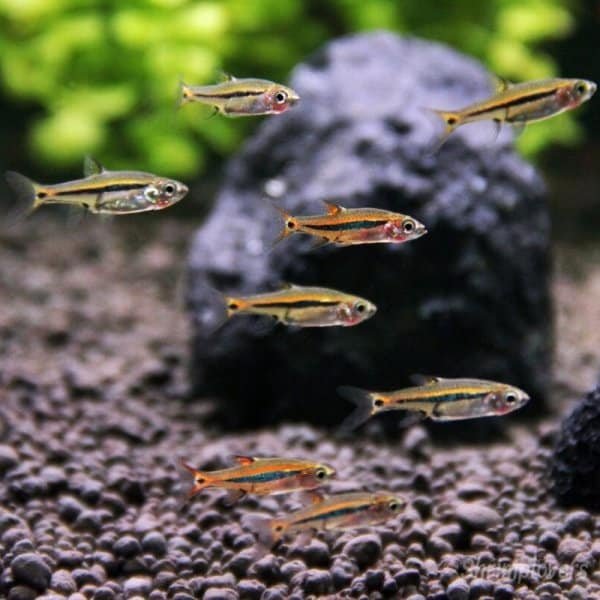
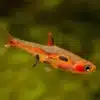
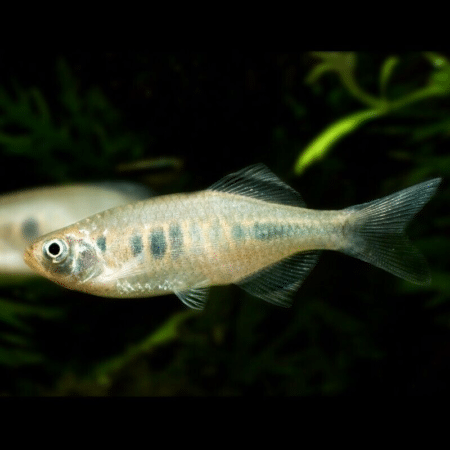
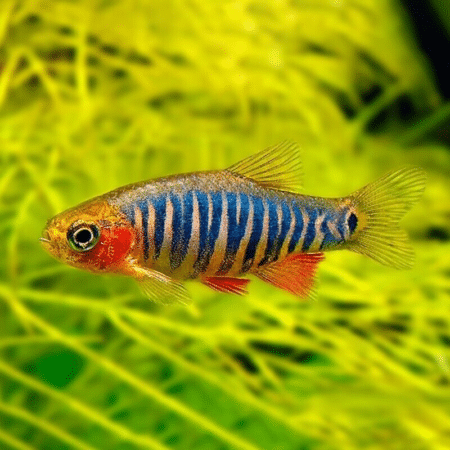
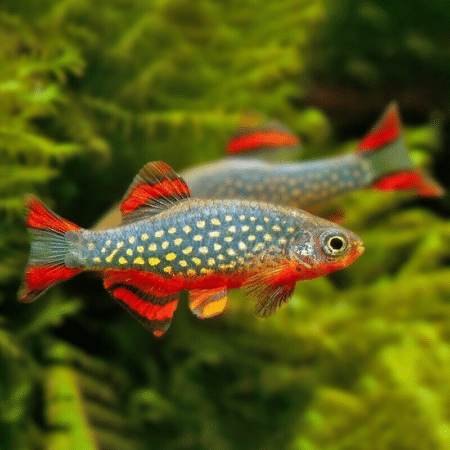


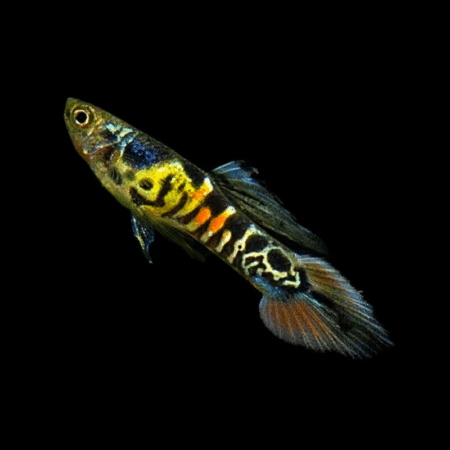


Emily Carter (verified owner) –
I recently added 6 Least Rasboras to my 20-gallon community tank, and I couldn’t be happier! These little guys have been a delight to watch. They settled in quickly, and after a week, they were confidently swimming around with my neon tetras and other tropical fish. I love their vibrant colors and the way they school together; it truly brings the tank to life!
I appreciate how hardy they are; I’ve had no issues with them adjusting to my tank’s parameters. They seem to thrive in a well-planted tank, which I’ve ensured to keep lush and inviting for them. Compared to other fish I’ve kept, like guppies, the Rasboras have a calmer demeanor and are great for a peaceful aquarium environment.
One minor note is that they can be shy initially, so be sure to provide plenty of hiding spots. I recommend these fish for both beginners and experienced aquarists looking to add a splash of color and movement to their tanks. Shipping was quick, and they arrived healthy. I’ll definitely be adding more in the future!
Emily Carter (verified owner) –
I recently added 6 Rasbora urophthalmoides to my 10-gallon nano tank, and I couldn’t be happier! These little freshwater fish are not only stunning with their vibrant colors, but they also have such a friendly disposition. After just two weeks, I’ve noticed how well they school together, creating an incredible display of movement and color in my aquarium. They’re definitely small fish, but their personality makes them feel larger than life! Compared to other schooling fish I’ve tried, like neon tetras, the Least Rasbora has been far more active and engaging.
I appreciate that they thrive in smaller environments, making them perfect for my setup. I’ve taken great care to maintain clean water and ensure a peaceful environment, and I can see they’re thriving. My only minor concern is that they can be a bit shy at first, so having plenty of plants and hiding spots helped them settle in quickly. I highly recommend these to anyone looking to add some dynamic energy to their tank; they’ll bring joy not just to you but to your aquarium as a whole. If you’re a caring fish parent like me, you’ll appreciate their lively nature and minimal care requirements!